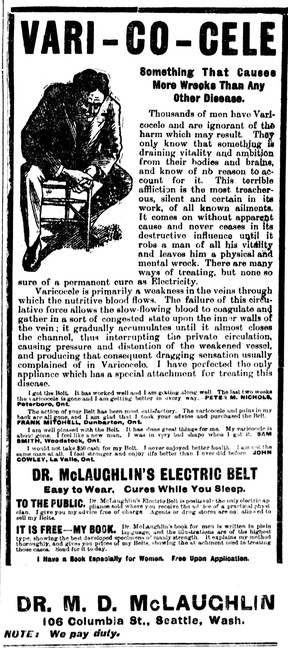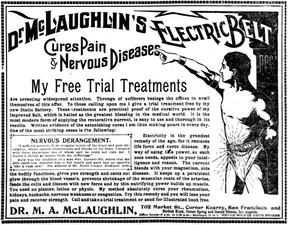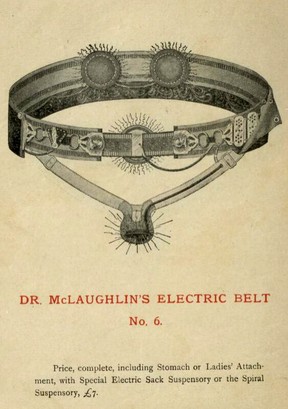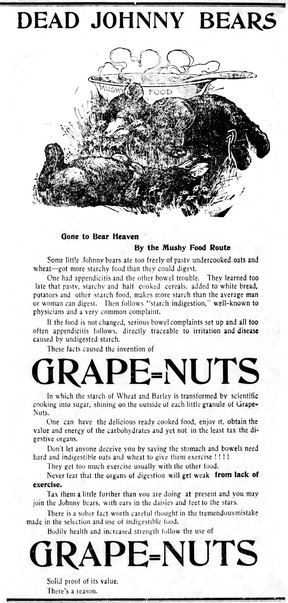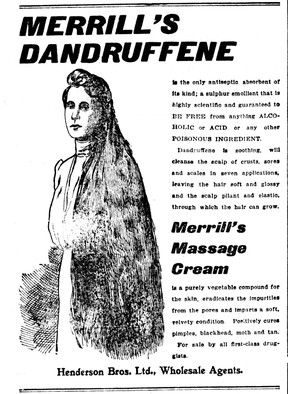The early 1900s were an era of many bizarre ads for health issues
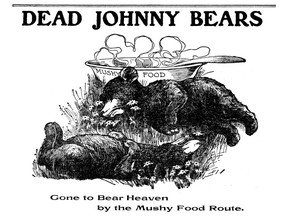
Ads in the early 1900s used all sorts of come-ons and snazzy illustrations to lure in readers. But some of them were just bizarre.
In the fall of 1903, for example, Grape-Nuts cereal touted its product with an illustration of two dead bears.
Start your day with a roundup of B.C.-focused news and opinion delivered straight to your inbox at 7 a.m., Monday to Friday.
Thanks for signing up!
A welcome email is on its way. If you don't see it, please check your junk folder.
The next issue of Sunrise presented by Vancouver Sun will soon be in your inbox.
“DEAD JOHNNY BEARS” read the top of the ad, which explained the poor hairy creatures had “gone to bear heaven” via the “mushy food route.”
“Some little Johnny bears ate too freely of pasty undercooked oats and wheat — got more starchy food than they could digest,” reads the ad.
“One had appendicitis and the other bowel trouble. They learned too late that pasty, starchy and half cooked cereals, added to white bread, potatoes and other starch food, makes more starch than the average man or woman can digest.
“Then follows ‘starch indigestion,’ well-known to physicians and a very common complaint. If the food is not changed, serious bowel complaints and all too often appendicitis follows, directly traceable to irritation and disease caused by undigested starch.
“These facts caused the invention of Grape-Nuts, in which the starch of wheat and barley is transformed by scientific cooking into sugar, shining on the outside of each little granule of Grape-Nuts.”
In 1907 Collier’s Magazine questioned whether Grape-Nuts could actually cure appendicitis, and Grape-Nuts incessantly attacked what it dubbed a “yellow” magazine. In 1910 Collier’s sued for libel, and won, although the judgment was set aside a year later.
In any event, Grape-Nuts — which contains no grapes or nuts — is considered a healthy food. And it’s still being made, 125 years after it was invented by Charles William Post, of Post cereals fame.
That’s more than can be said of many of the miracle health aids and cures you find in 1903 ads.
In the Oct. 2, 1903 Province, there is an ad for Merrill’s Dandruffene, “a sulphur emollient that is highly scientific and guaranteed to BE FREE from anything ALCOHOLIC or ACID or any other POISONOUS INGREDIENT.”
What did it purport to do? Cure dandruff and “cleanse the scalp of crusts, sores and scales in seven applications.” To illustrate, the ad featured a woman with lustrous hair down to her knees.
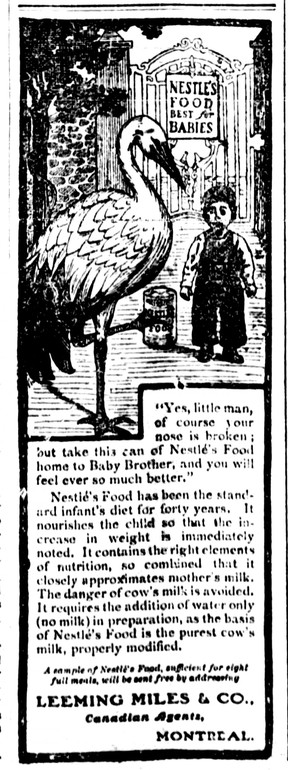
The following day the Province had a Nestle’s Food ad with a stork, a young child and a very odd message.
“Yes, little man, of course your nose is broken; but take this can of Nestle’s Food home to Baby Brother, and you will feel ever so much better.”
Honest, that’s what it says.
Many ads were aimed at “weak” men suffering from health problems you’ve never heard of, such as varicocele, which was “draining vitality and ambition from their bodies and brains.”
The cure, according to an ad in the Oct. 1 Province, was Dr. McLaughlin’s Electric Belt, a device that was incredibly popular at the time. The company’s ads were fantastic, showing zaps of electrical energy coming out of the belt, which was usually worn by some buff fellow.
The Dr. McLaughlin’s ads in Vancouver had a Seattle address, but the company was international: The National Library of Australia has digitized a 93-page book Dr. McLaughlin handed out with his belts and it lists offices in New York, Chicago, San Francisco, Toronto, Montreal, London, Paris, Berlin, Vienna, Madrid, Rio de Janeiro, Calcutta, Sydney and many other cities.
Illustrations of the belt make it look quite impressive, like something a Pharoah would have worn for style in ancient Egypt. Except this belt came with a “powerful silver plated battery” and “special cushion non-blistering electrodes.”
Some of the belts look kind of ominous, though, because they featured a “special electric sack suspensory.” Think of a men’s athletic supporter that is electrified, which seems kind of scary.
But this didn’t seem to effect its popularity with the masses, who were seduced with lines like “Every physician of modern ideas is an advocate of electrical treatment, and concedes that it stands far above all medical agents, especially when applied to diseases relating to the nervous system.
“This is a practical admission of the power of electricity over the nerves and vital organs, hence it must be evident to a thinking person that a means of intelligently applying this wonderful agent should be the greatest boon to suffering humanity.”
jmackie@postmedia.com
